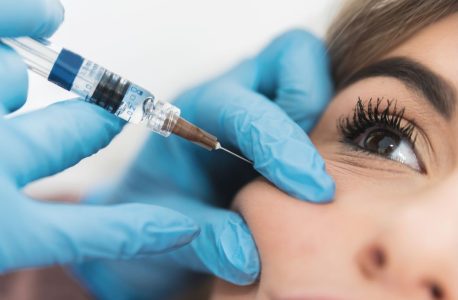If fat and sagging legs are something that bother you, a Cruroplasty could be the answer you are looking for.
Also known as a thigh lift, a Cruroplasty is a plastic surgery that aims to eliminate excess fat and skin in the thigh region, providing very satisfactory results for those who want firmer legs and a more defined contour.
In this article, we will explore everything you need to know about cruroplasty surgery.
What are the causes for saggy legs?
Several causes can contribute to loss of firmness and sagging in the thigh area, including:
- Aging Over the years, the production of collagen and elastin in the skin decreases, leading to a loss of elasticity and firmness.
- Weight fluctuation Repeatedly gaining and losing weight can overstretch the skin, resulting in sagging, especially on the thighs. It is very common for patients undergoing bariatric surgery to seek this type of surgery (post-bariatric) to remove the excess skin.
- Sedentary lifestyle A sedentary lifestyle, which involves a lack of regular physical activity, can affect the general health of the skin and muscles, indirectly contributing to cellulite and sagging.
- Pregnancy During pregnancy, weight gain and skin area expansion can lead to stretch marks and saggy legs.
- Genetics Genetic predisposition plays an important role in sagging skin, as each person’s genetic structure determines the quality of their skin.
What solutions exist to treat saggy legs?
To treat saggy legs, there are several options, including physical exercise, firming creams, non-invasive or minimally invasive treatments and surgical procedures.
Specific exercises, such as squats and lunges, can tone leg muscles, but may not resolve extreme sagging skin.
Although there are products on the market (such as firming creams with a lifting effect) that promise to improve skin firmness, their results are generally very limited.
For milder cases of sagging legs, we recommend invasive or minimally invasive treatments, such as Morpheus 8, body radiofrequency, EMSculpt NEO or EMTone.
However, Cruroplasty is considered one of the most effective solutions for people with a lot of fat and sagging who want long-lasting and visible results.
What is a Cruroplasty?
A Cruroplasty, also known as Thigh Lifting or Crural Dermolipectomy, is a surgical procedure performed to correct sagging and excess skin on the thighs. It can be complemented with liposuction of the fat located in this region. The surgery aims to improve the appearance and firmness of the thighs, providing smoother and more aesthetic contours to the lower part of the body.
To whom is a Cruroplasty recommended?
A Cruroplasty is recommended for all people who have excess skin, not just excess fat, in the thigh area. Typically, this surgery is indicated for more serious cases of sagging, excess skin and fat on the legs.
Normally, a Cruroplasty can be recommended after the age of 18 and when the ideal weight for surgery is reached. If you are in the growth phase or in the process of gaining or losing weight, the skin may undergo changes, which alter the surgery results.
A Cruroplasty, like any plastic surgery, must be performed on individuals who are non-smokers or who are willing to stop smoking during the period recommended by the plastic surgeon.
It is important to remember that this surgery is not a substitute for weight loss and should not be performed as a weight loss solution.
Before undergoing a Cruroplasty, it is essential to consult your plastic surgeon to assess your eligibility for this surgery and discuss your expectations.
What type of anesthesia is used in a Cruroplasty?
Cruroplasty is performed under general anaesthesia, generally with a 1-night hospital stay.
How long does Cruroplasty surgery last?
The duration of a Cruroplasty surgery can vary depending on several factors, including the extent of the procedure, the complexity of the case and the specific surgical technique used. On average, the surgery usually lasts between 2 and 3 hours, but this time can be longer or shorter, depending on the individual circumstances of each patient.
What does the scar look like after a Cruroplasty?
The scar resulting from Cruroplasty is a common concern for patients.
The extent of the scar may vary according to the degree of sagging and the surgical technique used.
In cases of light lifting, the scars are quite camouflaged as they are located in the groin. In cases where it is necessary to make an incision along the thigh (which can go up to the middle of the thigh or knee, depending on the case), the scar may be more extensive, however it is in the less visible area of the thigh, i.e. on the inner side.
The Living Clinic plastic surgeon will plan the surgery so that the scar is as discrete as possible. Over time, scars tend to become less noticeable, but it is important to follow the surgeon’s instructions for proper scar care during the recovery period. Still, the scar burden of this surgery is significant.
Living Clinic has several non-invasive or minimally invasive technologies for reducing scars, such as the Fractional CO2 Laser or Morpheus 8. Find out more on our Scars page.
What are the possible risks and complications of surgery?
Like with any surgical procedure, a Cruroplasty involves potential risks and complications. Some of the risks include:
- Infection;
- Bleeding;
- Seroma (fluid accumulation).
- Poor healing;
- Changes in skin sensitivity.
It is crucial to follow all pre- and post-operative instructions and attend follow-up appointments to minimize these risks.
‘How long will I be away from work’?
The sick leave time after Cruroplasty may vary from person to person and depends on the extent of the procedure. Generally, patients can expect to be off work for about two to six weeks.
During this period, it is essential to follow the surgeon’s instructions and avoid any activity that could compromise the results of the surgery.
The post-operative period of a Cruroplasty (recovery and care)
The success of a Cruroplasty also depends on adequate post-operative care. Some essential precautions include:
- Use the compression band as instructed by the surgeon;
- Avoid direct sun exposure to scars;
- Maintain a healthy diet to promote good healing;
- Stay well hydrated;
- A bath is acceptable a few days after surgery, following the surgeon’s instructions. During the first few days, it is common for the patient to receive instructions to avoid wetting the operated area;
- You should follow the surgeon’s instructions for taking care of the scars. This may include the use of healing ointments or gels;
- Avoid smoking before and after surgery: tobacco is one of the main risk factors for the development of complications in the postoperative period.
Normally the post-operative period is not painful, but it is uncomfortable and restricts movement. If there is pain or discomfort, the patient should resort to prescribed analgesics.
The period for full recovery takes from 45 days to 3 months. It is contraindicated to practice intense exercise, sports and physical exertion in the first three months. After three or six months, as with any other surgery, healing will be complete.
What results can you expect after a Cruroplasty?
The results of a Cruroplasty are visible immediately after surgery, but the results become definitive as the operated area recovers completely.
Patients can expect firmer legs, less fat and sagging, with more defined contours and a more rejuvenated appearance of the legs.
The results are long-lasting, as long as the patient maintains a healthy lifestyle and avoids extreme weight variations.
Living Clinic has exercise professionals who are experienced in following patients through their recovery period.
Which physician performs the Cruroplasty?
Cruroplasty surgery is performed by Living Clinic’s Plastic Surgeon, Dr. Francisco Martins de Carvalho, and his medical team.
What is the price of a Cruroplasty?
The cost of a Cruroplasty depends on the needs and specificities of each case. Furthermore, publishing the costs of surgical procedures on the internet is generally prohibited. The price of the surgery is defined after a face-to-face and individual evaluation with the plastic surgeon. Schedule a consultation if you are looking for a cost estimate.
Cruroplasty after bariatric surgery (obesity surgery)
Many patients who have undergone bariatric surgery may experience sagging legs after losing weight. In these cases, a cruroplasty can be an effective option to remove excess skin and improve the shape of the legs. However, it is important to discuss this possibility with your plastic surgeon and consider the most appropriate time to perform cruroplasty after bariatric surgery.
Cruroplasty with Liposuction
In some cases, a cruroplasty can be combined with liposuction to obtain even more satisfactory results, especially in patients who have both excess skin and fat located in this region. This combination of surgical procedures can provide a significant improvement in the appearance of the legs and a more sculpted silhouette.
Cruroplasty: Before and After
The transformation provided by a cruroplasty is remarkable, and many patients are satisfied with the results.
Before deciding on the surgery, it is helpful to research before and after images of patients who have had the procedure to get a realistic idea of what to expect and what scars are involved.
Keep in mind that results may vary from person to person, but your Living Clinic plastic surgeon will work to achieve your aesthetic goals.
What other surgeries are there for body sagging?
In addition to the cruroplasty, there are other surgeries that can be considered to treat body sagging, depending on the affected areas and the patient’s individual needs. Some options include:
- Abdominoplasty: To treat a sagging belly;
- Brachioplasty: To treat sagging in the arms;
- Gluteoplasty or Butt Lift: To improve the firmness and shape of the buttocks;
- Facelift and Neck Lift: For facial and neck rejuvenation.
You can consult all plastic surgeries performed by Living Clinic on our Plastic Surgeries page.
In summary, a cruroplasty is an effective solution for sagging legs that can provide long-lasting results and a significant improvement in the appearance of your thighs. Schedule a consultation at Living Clinic, in Porto, to obtain personalized guidance on a Cruroplasty or find out about other treatment options for sagging thighs.
Plastic surgeon

Dr. Francisco Martins de Carvalho is a specialist in Plastic, Reconstructive and Aesthetic Surgery. He completed his degree in Medicine at the School of Medicine of the University of Oporto and the Internship in Specific Training in Plastic, Reconstructive and Aesthetic Surgery took place at Hospital de São José (Lisbon) and Hospital de São João (Oporto).
Currently, he is also a plastic surgeon at the Hospital de São João – Oporto, and Visiting Professor at the School of Medicine of the University of Oporto.
In the field of cosmetic surgery, he has a special interest in cosmetic surgery of the face, cosmetic surgery of the breast, body contouring surgery and cosmetic vaginal surgery.
Schedule an appointment
- Quer saber mais informações sobre algum tratamento?
- Deseja conhecer a Living Clinic?
- Quer a opinião da nossa equipa?
- Deseja marcar uma consulta?






